A cluttered wardrobe is like a computer full of junk files. It’s slow to operate and doesn’t perform well.
If you dread the idea of opening the wardrobe to choose an outfit, chances are your wardrobe is a jumble of clothes thrown every which way.
It’s apparent that you need to organize your wardrobe.
The four steps to organize your wardrobe are:
- Emptying and cleaning the wardrobe
- Then purging the piles of clothes.
- This is followed by organizing the space in your wardrobe by rolling the clothes, space-saving hangers, and boxes.
- Finally, maintain the wardrobe to prevent future clutter.
If this sounds like a complicated process, don’t panic. This comprehensive guide will walk you through this complex process and simplify each stage into easy-to-follow steps.
Read on to find out how to organize your closet the easy way.
Why is Your Wardrobe Cluttered?
There are two reasons why your wardrobe is always cluttered, and you can’t find the piece of clothing you want when you look for it.
The first reason is that you have too many clothes.
You buy clothes on a whim, stuff them into the wardrobe, and then forget about them.
Online shopping has made shopping for clothes a breeze. You just pick and click, and the next thing you know, you have a few more pants or skirts on their way to your doorstep.
But, unfortunately, the more clothes you buy, the more you lose track of what you actually have in your closet.
The second reason for a cluttered wardrobe is poor space management.
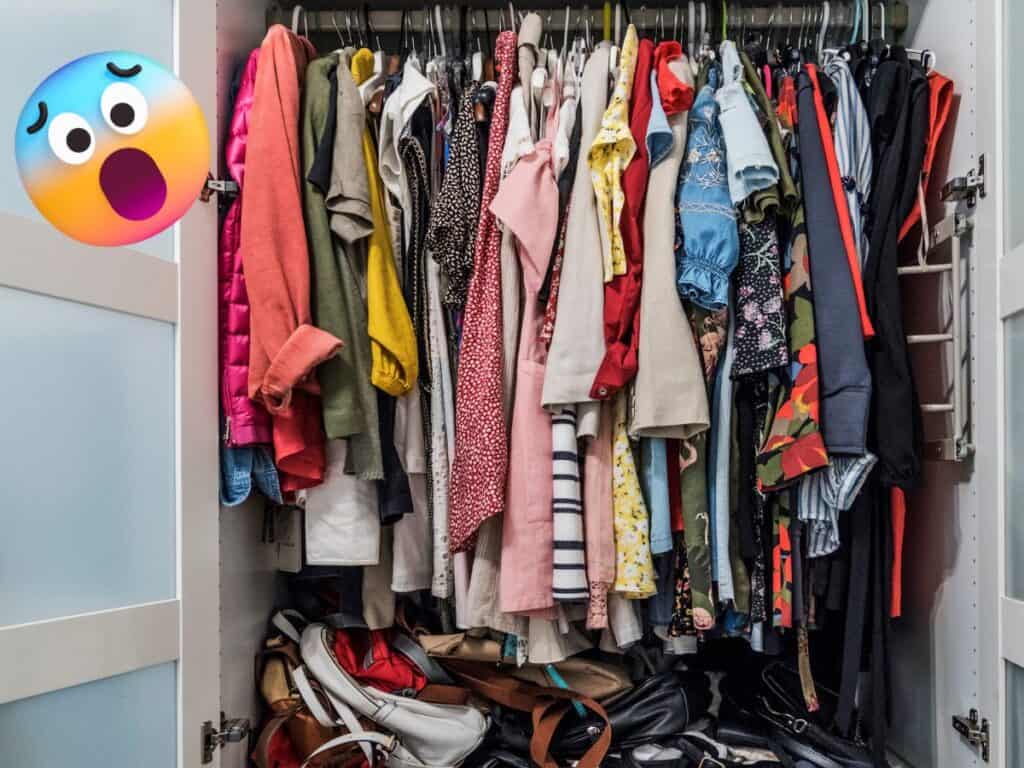
If you’re like most people, then you like to hang clothes in the most convenient space available in the wardrobe.
If you need to hang a new shirt, you just push the pants, dresses, and skirts aside to create space.
So what’s wrong with having too many clothes and lacking space management?
Well, for one thing, there’s nothing wrong with having a lot of clothes. But it’s not a good idea to have too many clothes.
This implies that there are clothes lying in the closet redundantly that you either no longer need, or worse, have totally forgotten about it.
These redundant clothes have no place in your wardrobe. You can think of better ways for them. I’ll give you a few ideas to put those forgotten clothes to better use later.
The second issue is poor space management which turns the wardrobe into a clothes dump.
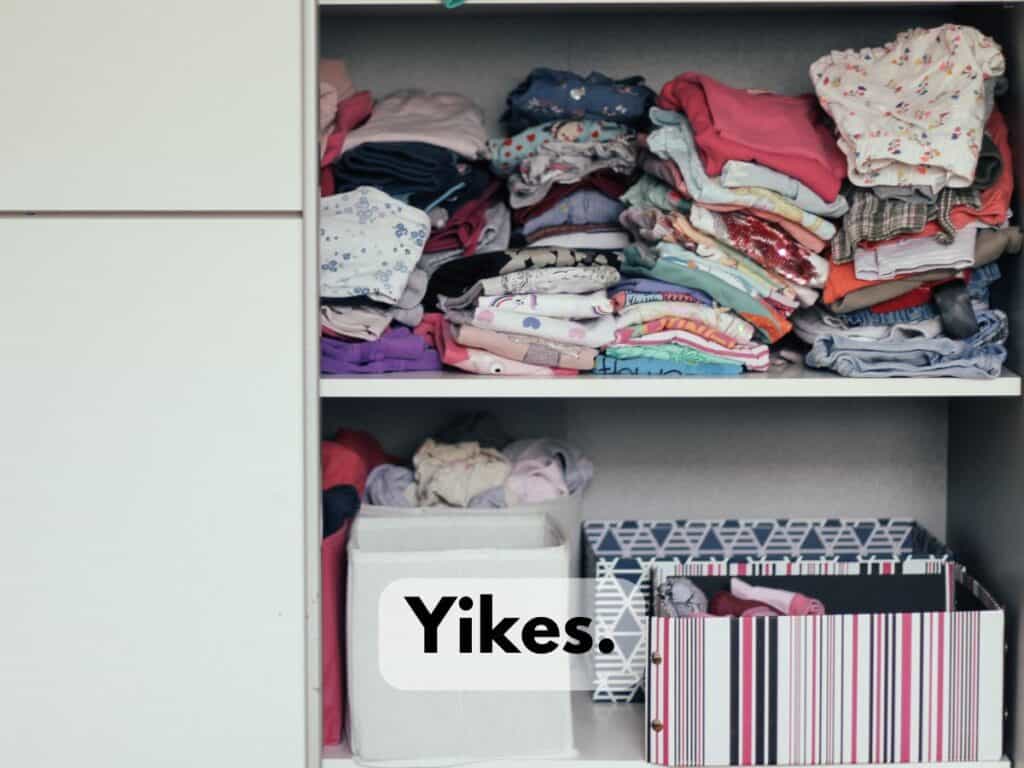
The skirts and dresses are crowding the cardigans and wool sweaters which are piled up on top of the winter coats, the denim pants, and the velvet jacket your aunt gifted you a few winters back.
And hidden under all these piles of clothes are new items that you haven’t even used once. They’re either out of fashion now, or they no longer fit.
Signs Your Closet Needs Organizing
Don’t get me wrong. I’m not a neat freak. But I can tell when the wardrobe of a friend of mine needs organizing or not.
It’s true that some people thrive in situations like these, like a messy closet. They would dive head first into the wardrobe and come up for a breath a few times before they finally emerge victorious with two or three mismatching items.
Here are the 14 signs that your closet has turned into a clothes dump.
- The clothes you hang in the closet are already wrinkled from being jammed into a tiny space for too long.
- The shoes come out of the clothes mangled and flat because you squeezed them in there and dropped heavy clothes over them.
- When you take out a purse to use, you’ll find another purse inside of it. You don’t have enough space, so you cram the bags and purses inside of each other like Russian dolls.
- Ties and scarves are piled up on top of each other. When you need a scarf, you pull out the one on top because you have no access to the ones hidden under the pile.
- The shoes at the further corner of the wardrobe that you haven’t used in a long time are already covered with dust.
- Wool clothes have mite holes in them.
- Socks spill out of the drawers, and you don’t have the time or inclination to reach for the ones at the bottom of the drawer.
- You ran out of space to keep the new undies because the drawer is overflowing with old ones.
- It’s not easy to find that yellow blouse you know you had put in the wardrobe only the week before.
- The hats are precariously piled into a tower that threatens to keel over any moment.
- The back wall of the wardrobe, the floor, and the further corners are a mystery to you because you haven’t explored those parts in ages.
- Too many piles on the floor of the wardrobe, you dare not get in there; otherwise, you may spend hours sorting through clothes.
- You tend to find it easier to buy an item online than to look for it in the closet.
- Your belts are twisted beyond recognition. When you wear one, the bent edge of the belt bites into your waist.
From the above, it’s clear that you need to organize your wardrobe urgently.
If you put it off any longer, the wardrobe will become off-limits, and you might have to buy a new closet with new clothes.
The four key stages of bringing some order into a cluttered and messy wardrobe are:
1. Empty and Clean
This is a two-fold step with two processes that go together.
Empty the Wardrobe
The first step toward organizing your wardrobe is to take out everything in there and run a thorough audit. You want to know what is taking up space in your closet and whether it’s worth keeping or not.
I recommend that you devote a whole day to this process. If your wardrobe has four or more of the signs in the previous section, chances are you’ll need a whole day to sift through all of these clothes.
Spread a clean sheet on the floor and make sure you have enough space on the floor for a whole bed sheet.

Otherwise, you’ll end up piling the clothes on top of each other, which can be daunting to categorize them, as we’ll see in the purging section below.
You also need space around the sheet to work around and fish out the clothes that fit into each category or pile. On top of that, you need extra space for each pile.
If the bedroom doesn’t have this amount of free space, I suggest you spread the bed sheet in the living room after pushing the coffee table and any chairs up against the wall.
Then you’ll need to make a few trips from the closet to the living room to get everything in the closet out.
It’s ok to pile the clothes by the armful in separate piles. But don’t make one big pile in the middle. This pile is hard to go through, and takes longer to take the above-mentioned inventory.
If the shoes get added to the belts and bags, that’s fine. If the undies end up with the coats, that shouldn’t be a big concern.
As long as you keep the content of the wardrobe in small piles, you’re on the right track.
Clean the Wardrobe
Once you have got every last piece of clothes and wayward sock out of the wardrobe, take some time to clean it. You should do this before you even sort out the piles of clothes.
Why?
Because cleaning the wardrobe takes time, and takes even longer before the wardrobe is ready to organize the clothes in it again.
So while the wardrobe is drying and ventilating, you can purge the clothes without wasting much time.
Cleaning the wardrobe goes through 4 essential steps
1. Vacuum the Carpet

The floor of the wardrobe has collected plenty of debris and dust since the last time you cleaned.
Dust on shoes and clothes tends to fall to the floor, and if it meets some moisture or damp conditions, it turns into mud.
From there, it’s only one step away from mildew and mold build-up.
Use the vacuum to get every iota of debris and every speck of dust off the carpet. You might have to go over the corners more than once.
If you find mildew, treat it with a mildew remover.
I also wrote a step-by-step guide on removing mildew from your clothes that may interest you.
2. Wipe Down the Shelves
Much like the floor of the wardrobe, shelves are horizontal surfaces that dust pools over. Use a clean washcloth to wipe down those shelves both at the top and the bottom.
Do the same for the drawers as well. Give the bottom and sides a good once over. If you find any stains or grime, leave it there.
You’ll deal with it in the next step.

3. Scrub the Grime
Grime in the wardrobe is to be expected. It doesn’t mean that your house cleaning habits are to be criticized.
The grime collects on the soles of the shoes and jeans, and leather jackets that find their way into the wardrobe.
Scuff marks can also result from a crowded wardrobe where you jam heavy clothes with large buttons wherever they fit.
Patiently treat the grime and scuff marks with a sponge dipped in white vinegar, then wipe it off and rinse with another wet sponge. Dry it off with a paper towel to soak up the excess moisture.
4. Air the Wardrobe
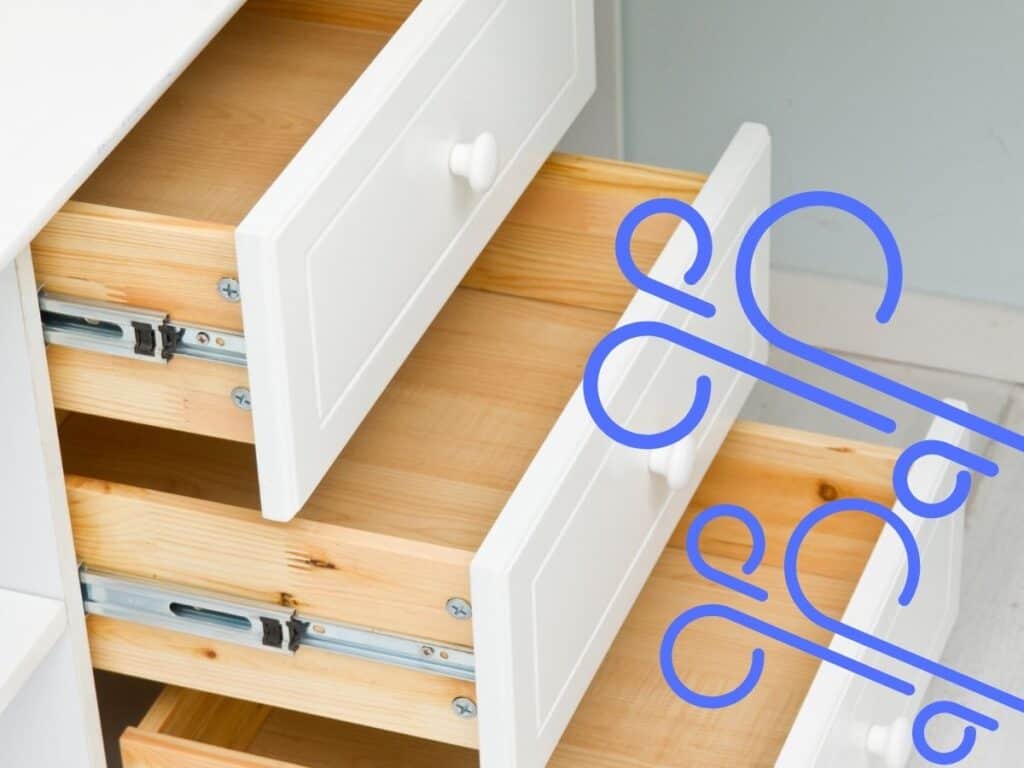
Finally, leave the door and drawers open to allow the air to dry out the wardrobe and chase out any odors. You can place a fan in front of the open closet and let it blast air inside.
Meantime, you can tend to the bigger task of sorting out the clothes you left on the sheet in the first part of this step.
2. 4-Pile Purge
While the wardrobe is drying out and getting ventilated, you can now turn your attention to piles of clothes on the floor.
Before you even begin this arduous task, you’ll need to spread out another sheet next to the first one.
Better still, if you can place four sheets side by side.
These extra sheets will have the sorted-out piles after you go through the purge step that gives you four piles.
I recommend using sheets of different colors to help you sort out the clothes faster.
So What is the 4-Pile Purge?
As the name implies, you’ll purge the content of the wardrobe and break it down into just four piles.
You can use a green sheet for the pile to keep, a blue one for the pile to store, a red sheet for the pile to donate or sell, and a brown sheet for the pile to throw out.
1. Pile to Keep
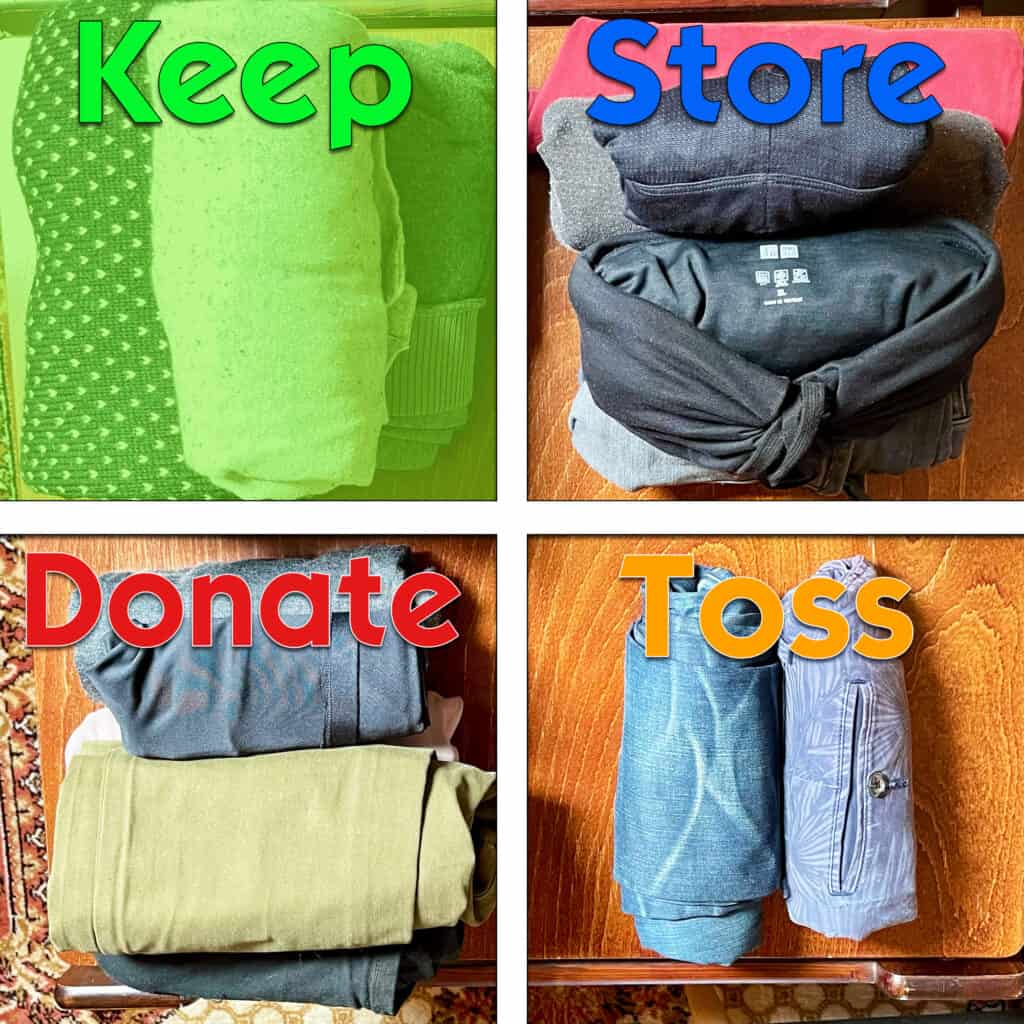
As you pull clothes, shoes, belts, and bags out of the large sheet, inspect each item quickly and make a quick decision as to which pile it goes on.
It’s easy to get caught up in memories and nostalgia and spend more time than you should.
The pile to use should have all the clothes that you’re currently using. These include office wear, home wear, activewear, and all the clothes that belong to this season.
If it’s summertime, then all the summer clothes that you want to wear will be piled neatly on this sheet.
Don’t bother folding the clothes for now. There’s a step for that which will come later. Work fast and furious, and don’t second-guess yourself.
If you like it and it fits, throw it on this pile.
2. Pile to Store
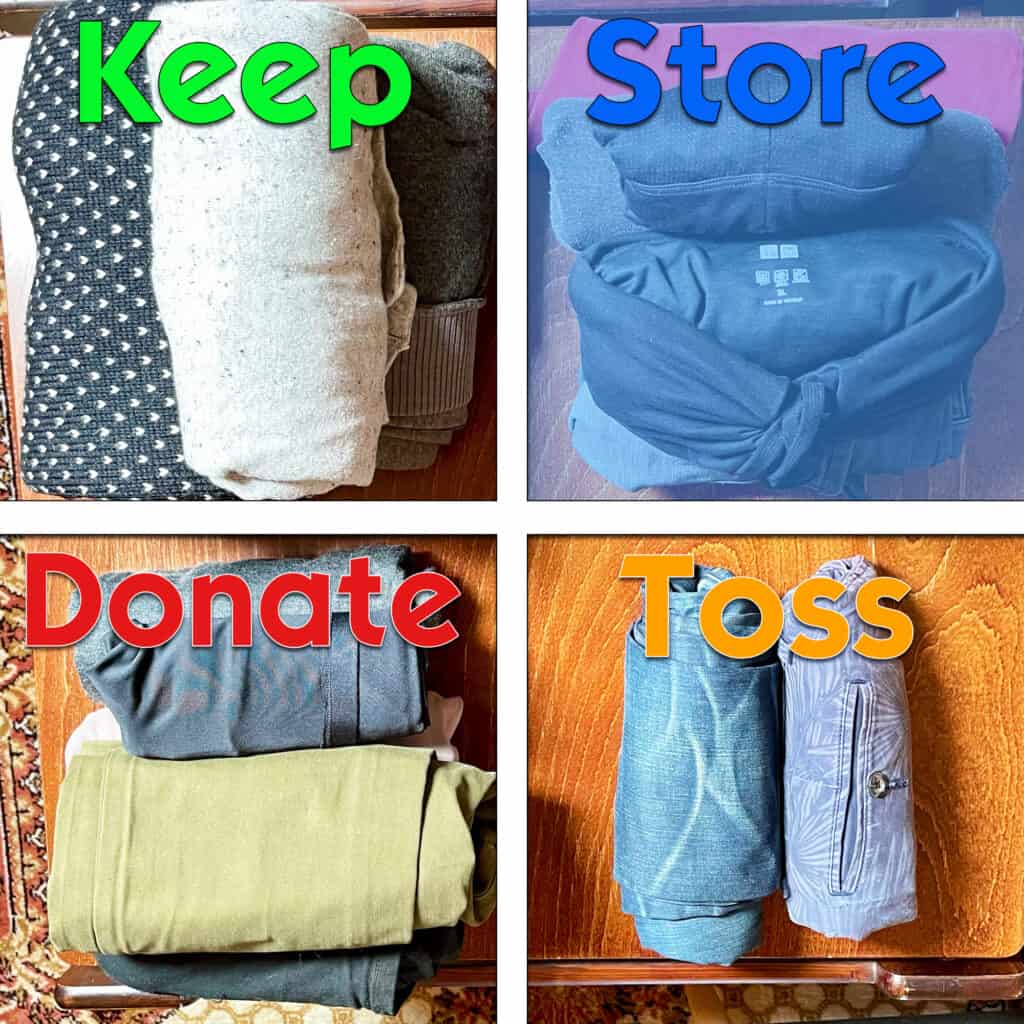
Clothes that are in good shape, have not gone out of fashion, and still fit you but are seasonal clothes, or you’d want to keep them for very special occasions, these clothes should go on the second sheet—the pile to store.
These include out-of-season clothes. Assuming this is the summer, then all the heavy clothes, wool fabrics, cardigans, sweaters, and coats should fall on this pile.
Clothes that you keep for weddings and formal occasions, such as expensive dresses and suits also belong here.
You don’t wear them every day. So it’s better to store them and save space in your wardrobe.
3. Pile to Donate
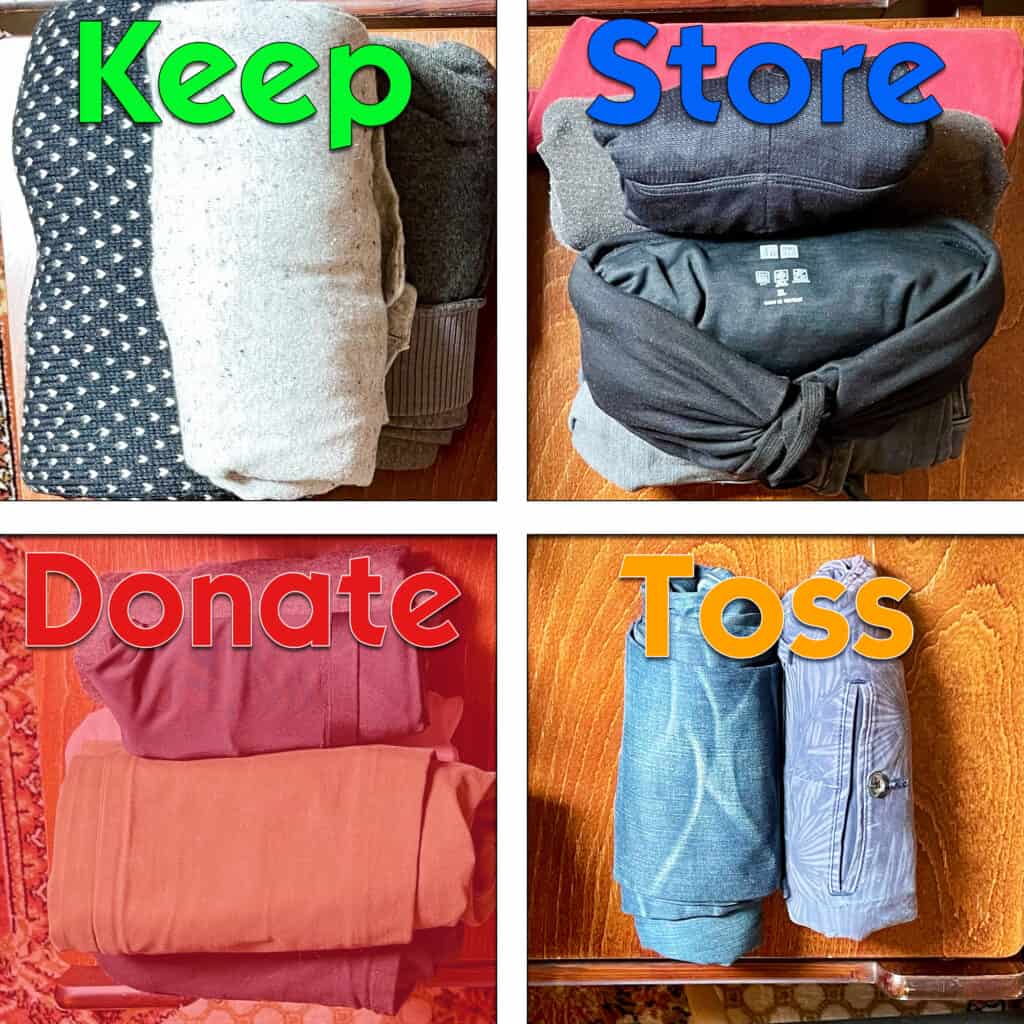
The next pile is for clothes that are in good shape but you don’t see yourself wearing anymore. They could be one or more sizes too small or too big. They could be out of fashion but still as good as new.
This pile should also include clothes that you bought on a whim and haven’t put on even once. If you didn’t wear them at the time you bought them, you’re not going to wear them any time in the future. Just let them go.
Add to this pile all the wearable gifts you got but hated on the spot. The knitted sweater your grandma gave you for Christmas with all the motionless deer certainly belongs here.
This pile is for donation. But you can also resell them online or at the flea market. You could make a quick buck while decluttering your wardrobe. That’s a win-win situation.
4. Pile to Throw Out
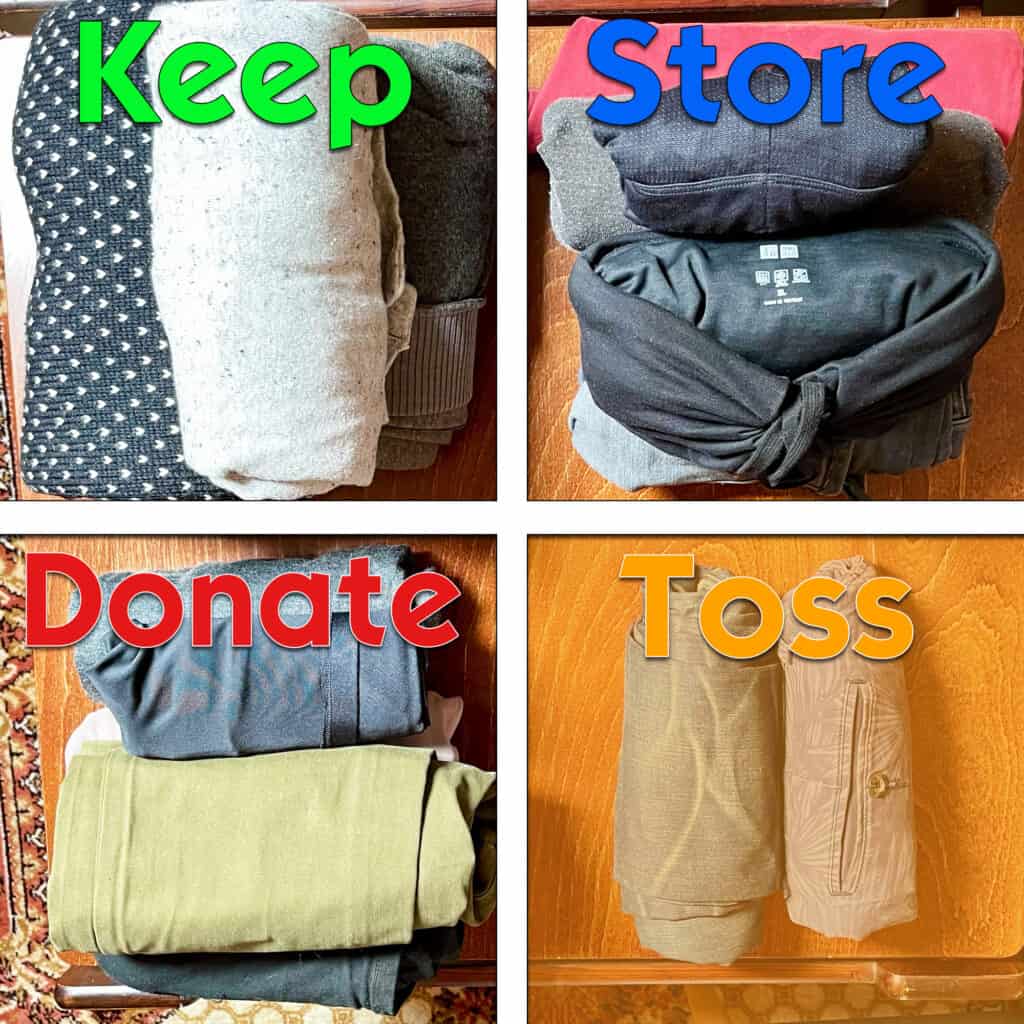
When you come across an item with its best days behind it, it’s time to get rid of it. Drop it on the last sheet. Old clothes that have faded or turned yellow beyond recognition need to be thrown out.
The same goes for torn clothes, worn-out clothes, and shoes that have reached the end of their life. Just do the decent thing and throw them in the trash.
Don’t spend too much time on a single item. No matter what memories or emotional baggage the item triggers, suppress the urge to reminisce and just decide on which pile it belongs to.
Some old items deserve to be stored and not thrown out.
Like that shawl passed on to you from your mother, who in turn got it from her own mother. If it has too much sentimental value for you, you should store it. The rest must go.
3. Organize
Now you’re halfway through the task of organizing your wardrobe. And you still have a ways to go. You now have to work only with two piles: the one to keep and the one to store.
The pile to throw out doesn’t need any more processing, while the pile to donate or sell can be put off until you’re done with the closet.
To organize your wardrobe, you’ll give priority to the first pile, the pile to keep. Storing can be done even outside of the wardrobe in storage boxes, as we’ll see later.
Organize the Pile to Keep
This should be, by far, the largest of the four piles. It has all your work clothes, the clothes you wear at home, casual clothes, activewear, and all the shoes, purses, belts, and bags that go with them.
To organize this pile, you’ll need to break it down into smaller piles by category as follows:
- Shirts
- Pants
- Jackets
- Work clothing
- Pajamas
- Skirts
- Special category for designer dresses, suits, and costumes
Next, you need to go through each neat pile and arrange it by color. The dark colors should be on the bottom, with the lighter ones at the top.
And that concludes all the sorting you need to do out of the closet.
Next, it’s time to arrange them in the wardrobe. The following steps will simplify this process.
- To save space, you can use space-saving hangers. These are four or 5-tier hangers that let you hang up to 10 items on a single hanger. The hangers are slim and sturdy and take up less space in the wardrobe.
- Another way to save space is to either file-fold or roll up the clothes. This usually works for some clothes better than others. T-shirts, casual clothes, and wrinkle-free clothes can be rolled up tightly and stored on a shelf or in a drawer.
- Other items of clothing, such as sturdy coats and jackets, delicate fabrics, and designer clothes, all should be hung in the vertical space in the closet.
- Thick items such as denim and towels should be stacked together on a shelf.
- To help you get the most out of every inch of space available in the wardrobe, I recommend using organizational tools such as containers, racks, hooks, and dividers. Not only do they save space, but they also keep each category neatly separated from the others for convenience and easy access.
- Hang each category by color, keeping the darker colors at the back. For anything with long sleeves, group them further by sleeve length and keep the longest sleeves behind the shorter ones.
- If you have more vertical space in the closet than horizontal shelves and drawers, then use containers both above and below the clothing rack to store small items. Shelf dividers come in handy to give you more storage space both above and below the clothing rack.
- You can keep the jewelry and accessories in a container of their own. Shoes go into one or more containers below the rack. As for bags and purses, they go into a container above the rack.
- Metal shoe racks save more space than containers. Keep a couple of metal shoe racks under the clothing rack to take up all the shoes that you wear regularly. Don’t use wood shoe racks since they’re bulky, while plastic shoe racks are not durable.
Stow Away the Pile to Store
When you’re done with the clothes that you use every day, it’s time to focus your attention on the second pile, the pile to store.
Go through the whole pile, sorting it out into smaller piles by category as you have done with the pile to keep above. Group together by category, and within each category, sort by color and length of sleeves.
When you’re done with this step, go ahead and break the small piles into two general categories.
The first category is clothes that can be folded or rolled up.
The second category is for clothes that wrinkle easily and need to hang.
Once you have your two general categories that each contain smaller piles, follow these steps.
- Tops and blouses that wrinkle easily should hang at the deep end of the clothes rack. They should be out of reach since you won’t be needing them until the season changes or an occasion arises.
- If there’s no space in the closet to hang these clothes, try file folding or rolling them up, and then store them in a container or in a drawer if there’s space left.
- Lightweight dresses should hang as well. They don’t take up much space, and you can hang them on space-saving hangers.
- Maxi dresses should be folded or rolled up. The straps tend to stretch if left on a hanger for too long.
- Cotton or blended dresses should be folded as well. They lose their shape easily on hangers.
- Heavy sweaters need to be folded and stacked in a container or a shelf.
- Jeans should be folded even if you’re going to use them regularly. Extra jeans that you store away need to be folded as they don’t crease easily.
- Bottoms that wrinkle need to hang. These include designer skirts and pants.
- Take advantage of unused space in the wardrobe, such as behind the door, to hang accessories. Use hooks to hang these small items and free up storage space in the wardrobe.
- Store shoes in clear containers and don’t cram all the shoes in one container. That’s a recipe for mangled and misshapen shoes.
- Socks, rolled-up T-shirts, and other tightly folded items should go in drawers.
4. Maintain
Wardrobe maintenance is a crucial part of keeping the wardrobe neat, organized, and easy to access at all times.
This will make the next time you want to organize the closet easier.
So what does wardrobe maintenance entail?
You can start by setting a schedule to clean your closet regularly. Every season or twice a year, go through the wardrobe to get rid of all the clothes that are too old or out of fashion.
It helps to have extra space in the wardrobe for newcomers.
When your wardrobe is full, and you buy new clothes, take out an equal number of old clothes from the wardrobe.
If you buy a skirt, a pair of tights, and two pairs of shoes, take out one skirt, one pair of pants or slacks, and two pairs of shoes from the wardrobe.
You don’t have to throw those away. You can store them or donate them.
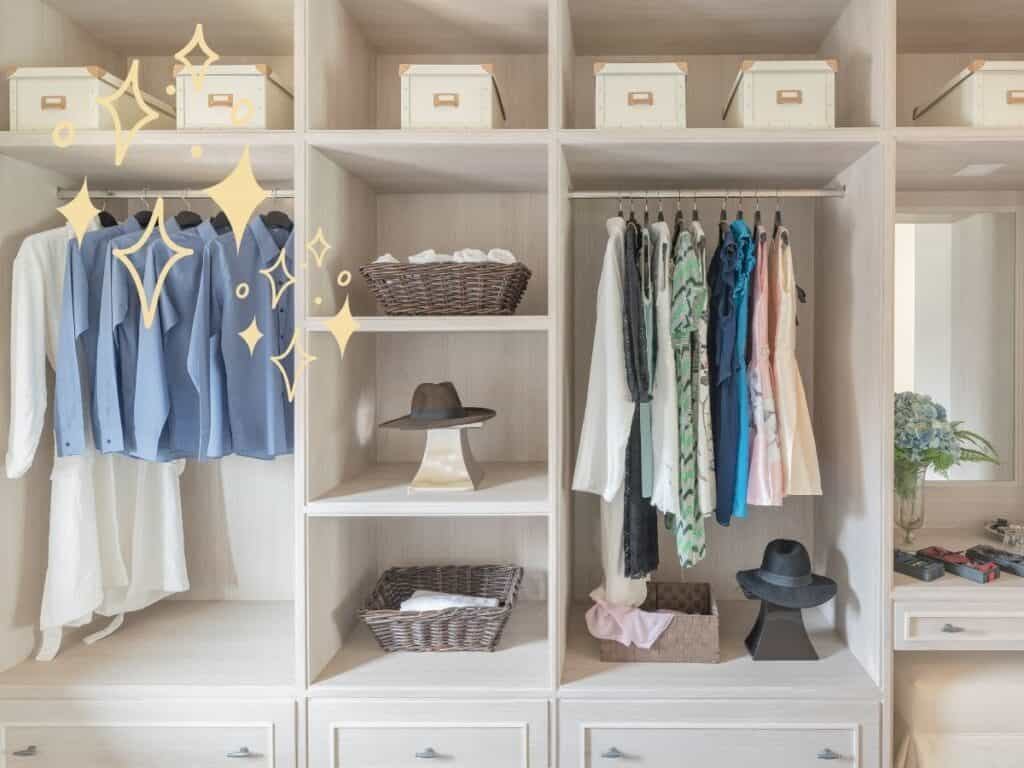
After a while, your closet becomes a mess again. When you take out items or do the laundry, you tend to just throw the clothes in the most convenient space in the wardrobe.
That will only make the next time you organize the wardrobe a lot harder.
When you put back an item, try to hang it or stack it along with its category—shoes with shoes, pants with pants, and so on.
Finally, try to organize your wardrobe after the end of each season. That way, you won’t have to keep winter clothes in the closet in the middle of the summer.

Keeping only season-relevant clothes in the clothes at all times is the best way to keep the wardrobe organized and clean.
Tips for Decluttering your Wardrobe
Decluttering your wardrobe is all about taking advantage of the available space you have and making the most out of it.
It doesn’t matter how small or big the closet is; there are ways to make it roomy and spacious to take all your clothes. Here are a few tips to help you along the way.

- Hefty Baskets: Baskets are ideal for taking advantage of every inch of space in the wardrobe. Place them under the long rack and fill them with heavy sweaters, jackets, and shoes.
- Rolling Cart: A rolling cart has shelves and is easy to move around. Place one in a corner in the wardrobe for your shoes. Or fill the shelves with little boxes containing your socks and accessories. Push it out of the way or even pull it out of the wardrobe to access the shelves behind it, then roll it back in and close the wardrobe.
- Over-the-Door Rack: The space behind the door of the closet can be used to store socks, undies, accessories, onesies, muslin clothes, and others.
- Hang Boots: Boots take up space on the floor of the closet and are prone to be banged out of shape if squeezed into a tiny space. Hang them on a low rack using clippers to free up space.
- Clothes Dividers: When hanging pants, dresses, coats, and other long clothes, separate each group with clothes dividers. Label them to get to the outfit you want without searching for it for long.
- Shower Rings: Small items like scarves, ties, and tights don’t need a hanger each. Fill the hanger with shower rings and hang each item through a ring. Save space and keep all your scarves on a single hanger or two.
- Hooks: Use hooks just about on every available space on every wall inside of the closet, even on the door. Now hang all the accessories you often use on the hooks for easy access.
- Glasses on a String: Don’t keep your glasses in a drawer or on a shelf. Just plug two hooks on the wall and tie a string between them. Now you can hang your glasses on the string.

Conclusion
When you have too many clothes in the wardrobe, chances are some of them are no longer wearable, some are old, and some are not even right for the season.
Go through your wardrobe, give it a thorough cleaning and make an inventory of its content.
Group the clothes together and use baskets, hooks, and shelves to organize your wardrobe.
For more great wardrobe organizing and clothes folding ideas, subscribe to my newsletter.

I’m an expert wardrobe organizer and a bit of a clean freak. I created this website and its YouTube channel to share practical guides about laundry and organizing. My teachings have been featured in multiple large news publications, and I’ve self-published two wardrobe organizing books and an entire course on the subject.

